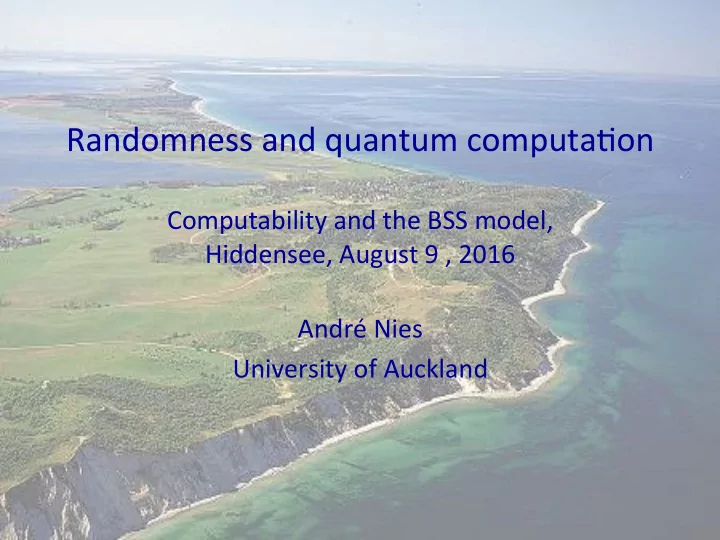

Randomness ¡and ¡quantum ¡computa/on ¡ ¡ Computability ¡and ¡the ¡BSS ¡model, ¡ Hiddensee, ¡August ¡9 ¡, ¡2016 ¡ ¡ ¡ André ¡Nies ¡ University ¡of ¡Auckland ¡
¡ ¡ 00100111000101111010101000010101101111011000010111101010 ¡ 10010101100011111010110001100111111101100000111001111000 ¡ 00110011011110100011110100011100101011011001011100010110 ¡ 01100110001111000010011001011101100100101000001110001111 ¡ 11100100011000101111110100010111110011011100100110011010 ¡ 00111111011010101101001101010110000011000001001101011100 ¡ 00111000000000111000110000011101100001001100000001111011 ¡ 00001000110011000100110100011100110111010101111010100111 ¡ 11111011001001111101110111110000001010110011101001000100 ¡ 01100001010000101010110011001100110110001101011010110001 ¡ 11110010100001110001001100011101110101111100001110101000 ¡ 01100011001010010010111011011000111101000111111000101111 ¡ 00111001000100101101000010011110011111101100011111110110 ¡ 01001001001011010001010000110100010100011100001100000100 ¡ 11000111110111001000011001011010100111101111010101111111 ¡ 00000001010011110010000000011011001010011010101101000010 ¡
¡ ¡ 00100100001111110110101010001000100001011010001100001000 ¡ 11010011000100110001100110001010001011100000001101110000 ¡ 01110011010001001010010000001001001110000010001000101001 ¡ 10011111001100011101000000001000001011101111101010011000 ¡ 11101100010011100110110010001001010001010010100000100001 ¡ 11100110001110001101000000010011011101111011111001010100 ¡ 01100110110011110011010011101001000011000110110011000000 ¡ 10101100001010011011011111001001011111000101000011011101 ¡ 00111111100001001101010110110101101101010100011100001001 ¡ 00010111100100100001011011010101110110011000100101111001 ¡ 11111011000110111101000100110001000010111010011010011000 ¡ 11011111101101011010110000101111111111010111001011011011 ¡ 11010000000110101101111110110111101110001110000110101111 ¡ 11101101011010100010011001111110100101101011101001111100 ¡ 10010000010001011111000100101100011111111001100100100100 ¡ 10100001100110010100011110110011100100010110110011110111 ¡
Did ¡you ¡no/ce ¡any ¡difference ¡ ¡ between ¡the ¡bit ¡sequences? ¡ ¡ ¡ • First ¡sequence: ¡896 ¡quantum ¡random ¡bits ¡ • Second ¡sequence: ¡the ¡ini/al ¡896 ¡bits ¡of ¡ ¡the ¡ binary ¡expansion ¡of ¡ π ¡-‑ ¡3 ¡ ¡ ¡ ¡ ¡ ¡ ¡ ¡ hPp://www.befria.nu/elias/pi/binpi.html ¡ ¡
10/11/2014 Pi - Wikipedia, the free encyclopedia It produces about 14 digits of π per term, [88] and has been used for several record-setting π calculations, including the first to surpass 1 billion (10 9 ) digits in 1989 by the Chudnovsky brothers, 2.7 trillion (2.7×10 12 ) digits by Fabrice Bellard in 2009, and 10 trillion (10 13 ) digits in 2011 by Alexander Yee and Shigeru Kondo. [89][1] For similar formulas, see also the Ramanujan–Sato series. In 2006, Canadian mathematician Simon Plouffe used the PSLQ integer relation algorithm [90] to generate several new formulas for π , Srinivasa Ramanujan, working in isolation in India, conforming to the following template: produced many innovative series for computing π . where is e π (Gelfond's constant), is an odd number, and are certain rational numbers that Plouffe computed. [91] Spigot algorithms Two algorithms were discovered in 1995 that opened up new avenues of research into π . They are called spigot algorithms because, like water dripping from a spigot, they produce single digits of π that are not reused after they are calculated. [92][93] This is in contrast to infinite series or iterative algorithms, which retain and use all intermediate digits until the final result is produced. [92] Compressibility ¡ American mathematicians Stan Wagon and Stanley Rabinowitz produced a simple spigot algorithm in The ¡binary ¡expansion ¡of ¡π-‑3 ¡can ¡be ¡compressed: ¡ ¡ 1995. [93][94][95] Its speed is comparable to arctan algorithms, but not as fast as iterative algorithms. [94] ¡ Another spigot algorithm, the BBP digit extraction algorithm, was discovered in 1995 by Simon given ¡n, ¡compute ¡the ¡first ¡n ¡bits, ¡using ¡that ¡ Plouffe: [96][97] ¡ ¡ ¡ The ¡length ¡of ¡this ¡ ¡descrip/on ¡ ¡is: ¡ ¡ This formula, unlike others before it, can produce any individual hexadecimal digit of π without calculating all the preceding digits. [96] Individual binary digits may be extracted from individual ¡ hexadecimal digits, and octal digits can be extracted from one or two hexadecimal digits. Variations of (Simon ¡Plouffe, ¡1995, ¡source: ¡Wikipedia) ¡ the algorithm have been discovered, but no digit extraction algorithm has yet been found that rapidly produces decimal digits. [98] An important application of digit extraction algorithms is to validate new claims of record π computations: After a new record is claimed, the decimal result is converted to http://en.wikipedia.org/wiki/Pi#Rapidly_convergent_series 12/29
Defining ¡Randomness ¡ ¡ Can ¡ ¡we ¡compress ¡a ¡long ¡sequence ¡ ¡ of ¡random ¡bits? ¡ ¡ ¡ ¡ NO. ¡ ¡ For ¡finite ¡objects, ¡incompressibility ¡can ¡be ¡taken ¡ as ¡a ¡formal ¡defini/on ¡of ¡the ¡intui/ve ¡concept ¡of ¡ randomness. ¡ ¡
Random ¡versus ¡paPerned ¡objects ¡ We ¡have ¡already ¡seen ¡that ¡random ¡objects ¡can ¡ resemble ¡paPerned ¡ones. ¡Here’s ¡a ¡musical ¡ example, ¡courtesy ¡of ¡D. ¡Hirschfeldt. ¡ ¡ Music ¡of ¡Changes ¡by ¡John ¡Cage ¡(1951) ¡ ¡ ¡ has ¡aleatoric ¡elements ¡ Structures ¡for ¡Two ¡Pianos ¡by ¡ ¡ Pierre ¡Boulez ¡(1961) ¡is ¡an ¡example ¡of ¡serialism ¡ (determinis/c ¡music) ¡ ¡ ¡ ¡
Music ¡of ¡Changes ¡(Cage) ¡ It ¡takes ¡random ¡samples ¡from ¡ ¡ ¡ I ¡Ching , ¡the ¡“book ¡of ¡ changes” ¡ ¡(which ¡the ¡Chinese ¡used ¡for ¡divina/on). ¡ ¡
Serialism ¡(Messiaen/Boulez) ¡ Based ¡on ¡a ¡ ¡12-‑tone ¡series, ¡which ¡ ¡ determines ¡all ¡the ¡other ¡musical ¡elements ¡
Compressibility ¡and ¡ ¡ ¡ ¡informa/on ¡content ¡ Objects ¡can ¡have ¡low ¡informa/on ¡content ¡for ¡ two ¡reasons: ¡ ¡ • Highly ¡compressible ¡ • Highly ¡random ¡ A ¡ ¡sequence ¡of ¡896 ¡zeros ¡is ¡highly ¡compressible, ¡ and ¡has ¡no ¡informa/on ¡besides ¡the ¡length. ¡ A ¡sequence ¡of ¡896 ¡quantum ¡random ¡bits ¡is ¡ incompressible, ¡and ¡has ¡no ¡informa/on ¡besides ¡ the ¡length. ¡ ¡ ¡ ¡
BenneP ¡depth ¡ Charles ¡BenneP ¡ ¡(1988) ¡introduced ¡the ¡no/on ¡of ¡depth ¡ to ¡gauge ¡ ¡the ¡amount ¡of ¡useful ¡informa/on ¡in ¡an ¡object. ¡ ¡ To ¡be ¡deep ¡means: ¡the ¡longer ¡a ¡running ¡/me ¡you ¡allow, ¡ the ¡more ¡paPerns ¡can ¡be ¡discerned. ¡ ¡ With ¡more ¡/me, ¡the ¡object ¡can ¡be ¡compressed ¡further. ¡ ¡ This ¡fails ¡for ¡both ¡random, ¡and ¡trivial ¡sequences. ¡ ¡ Examples ¡of ¡large ¡depth: ¡ Some ¡ ¡pain/ngs. ¡Some ¡Shakespeare ¡plays. ¡DNA ¡
Random ¡and ¡structured ¡parts: ¡Green ¡& ¡Tao ¡ The ¡dichotomy ¡of ¡random ¡versus ¡structured ¡is ¡ prominent ¡in ¡the ¡work ¡of ¡Green ¡and ¡Tao. ¡ ¡ Szemeredi’s ¡theorem: ¡every ¡set ¡of ¡natural ¡numbers ¡ with ¡ ¡posi/ve ¡upper ¡density ¡has ¡arbitrarily ¡long ¡ arithme/c ¡progressions. ¡ Each ¡of ¡the ¡known ¡proofs ¡proceeds ¡by ¡showing ¡ ¡ that ¡the ¡set ¡contains ¡a ¡large ¡ ¡(pseudo)random ¡ subset ¡of ¡a ¡structured ¡set ¡(Tao, ¡2006 ¡ICM). ¡ Green ¡and ¡Tao ¡(2006) ¡used ¡this ¡idea ¡ ¡to ¡get ¡ arbitrarily ¡long ¡ ¡arithme/c ¡progressions ¡in ¡the ¡ primes. ¡ ¡E.g. ¡5, ¡11, ¡17, ¡23, ¡29 ¡
Ulam’s ¡spiral ¡of ¡prime ¡numbers ¡ Souce: ¡Wikipedia ¡
¡ ¡ Examples ¡of ¡compression ¡ ¡ ¡ and ¡of ¡short ¡descrip/ons ¡
Recommend
More recommend